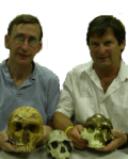Creativity
The Cerebellum, Creativity, and Neandertals
What does the cerebellum have to do with creativity?
Posted October 30, 2013
In a recent blog, we discussed the enhanced creativity and innovation that appeared to be so characteristic of Homo sapiens over the last 40,000 years. Archaeological evidence for the latter comes from spectacular, naturalistic cave paintings (Chauvet Cave), imaginative figurines (Hohlenstein-Stadel), a wide range and rapidly changing set of tools made from stone, but also bone and antler, spear throwers (Europe) and bow-and-arrow technology (South Africa), and ritualized burials (Sunghir in Russia). We ascribed these creative abilities to Enhanced Working Memory (or enhanced executive functions). Working memory is a relatively modern concept (1970s), which is generally thought to measure the ability to keep a goal in mind and strategies to reach that goal in spite of interference. We have published a number of articles where we suggest that Homo sapiens probably had greater working memory capacity than Neandertals. However, although enhanced working memory appears necessary for creativity and innovation (much innovation results from perseverance on task, which is an executive function), it may not be sufficient in and of itself.

So here is one very tentative working hypothesis, which we have not yet formally published: the cerebellum may have played a key role in upping the rate and creativity of innovations. In 2005, anthropologist Anne Weaver published a provocative article about the cerebellum's size in Neandertals. She claimed that it was smaller than that of Homo sapiens despite well documented evidence that Neandertal overall brains were larger than Homo sapiens!

A brief history of the cerebellum: we all learned (those who paid attention or even cared about such things 50 years ago) that “cerebellum” means “little brain,” and it sits posteriorly (behind) and inferiorly (below) the main part of the brain (cerebrum). We also learned that its primary function was the control of fine motor movements, like threading a needle, or stringing beads. Even until a decade ago, its cognitive functions were thought to be limited and that damage to the cerebellum produced few if observable cognitive repercussions. However, over the last decade, there have been some very exciting cognitive abilities attributed to the cerebellum: creativity and innovation among them.
The cerebellum is jam-packed with neurons. Volume-wise the cerebellum is about one-quarter the volume size of the rest of the brain but it contain up to four times the number of neurons. Scientists have most often ascribed this neuronal density as a property of the requirements of controlling fine motor movements. We now know, however, that there are extensive and reciprocal connections between the cerebellum and all areas of the cortex, including frontal, parietal, temporal, and occipital lobes. Clearly, something more than motor control is going on. All of these connections pass through the pons, a structure along the upper spinal cord. Now, it has been established that the anterior (front) portion of the cerebellum has neurons dedicated to fine motor movements, but its lateral and posterior portions may be sensitive to the neuronal functions of the other brain lobes.
So here's a provocative idea: what if, as in the case of the human hippocampus, the cerebellum’s original function was the guidance of motor fine motor movements, but evolutionarily some of its neurons were hijacked (called an exaptation) to perform a new function! Just as feathers on birds may have been initially strictly devoted to the maintenance of a body's temperature (thermoregulation) but evolutionarily developed (through other selective changes) the ability to fly, the cerebellum's other neurons were “exapted” to tweak “thoughts,” “ideas,” and “concepts,” “images” and “predispositions” from the major brain lobes, and these ideas were then “improved” just like fine motor-movements are tweaked while threading a needle?
A relatively new and recent perspective on cognition is known as embodied cognition. It argues that much of our thinking actually incorporates our bodies and the neural resources that evolved for movement (more on this in a future posting). If true, then the resources of the cerebellum may actually supply the neural foundations for higher level thinking. A percept or concept that arises in one area of the cortex is sent to the cerebellum and where it is transformed or modified in some fashion and sent back to that same part of the cortex (and/or other lobes) for further refinement. The process is repeated back and forth between the lobes and the cerebellum for additional refinements, before a final decision is made (probably by the prefrontal cortex).
Could this cerebro-cerebellar network be responsible for modern human creativity and innovation? Could the smaller cerebellums (if Weaver is correct) of Neandertals limited their imaginative abilities, limited their social cognitions, limited their abilities to imagine the future and entertain hypotheticals? It is an intriguing possibility, and yet still, the measurement of the cerebellum only by the the internal space in a fossil skull (as no brain matter preserves in fossils very well) remains a formidable challenge to modern paleoneurologists.


